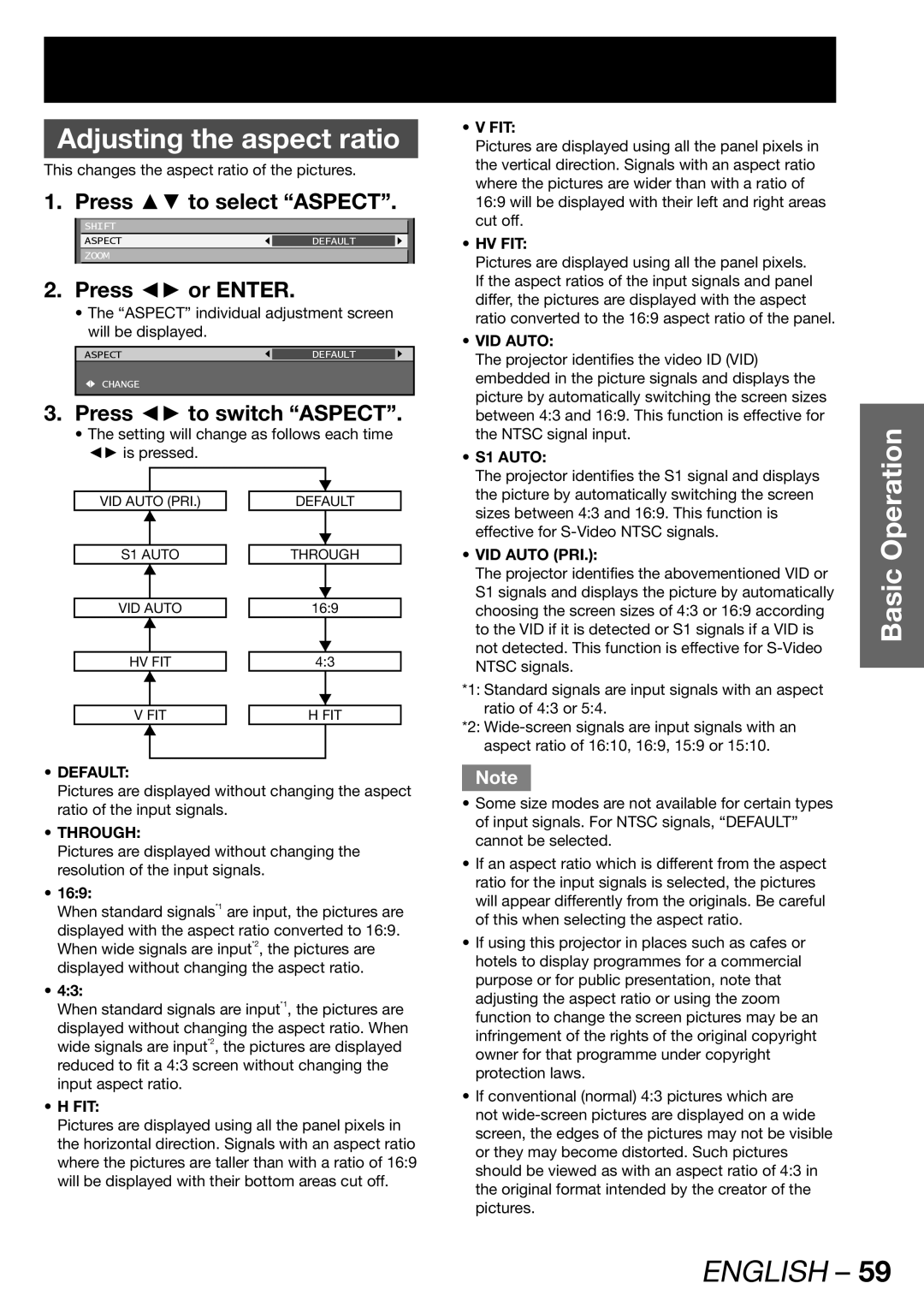
Adjusting the aspect ratio
This changes the aspect ratio of the pictures.
1. Press ▲▼ to select “ASPECT”.
SHIFT
ASPECT | DEFAULT |
|
|
|
|
ZOOM
2.Press ◄► or ENTER.
•The “ASPECT” individual adjustment screen will be displayed.
ASPECT | DEFAULT |
|
![]() CHANGE
CHANGE
3.Press ◄► to switch “ASPECT”.
•The setting will change as follows each time ◄► is pressed.
|
|
|
|
|
VID AUTO (PRI.) |
| DEFAULT | ||
|
|
|
|
|
S1 AUTO |
| THROUGH | ||
|
|
|
|
|
VID AUTO |
| 16:9 | ||
|
|
|
|
|
HV FIT |
| 4:3 | ||
|
|
|
|
|
V FIT |
| H FIT | ||
|
|
|
|
|
•DEFAULT:
Pictures are displayed without changing the aspect ratio of the input signals.
•THROUGH:
Pictures are displayed without changing the resolution of the input signals.
•16:9:
When standard signals*1 are input, the pictures are displayed with the aspect ratio converted to 16:9. When wide signals are input*2, the pictures are displayed without changing the aspect ratio.
•4:3:
When standard signals are input*1, the pictures are displayed without changing the aspect ratio. When wide signals are input*2, the pictures are displayed reduced to fit a 4:3 screen without changing the input aspect ratio.
•H FIT:
Pictures are displayed using all the panel pixels in the horizontal direction. Signals with an aspect ratio where the pictures are taller than with a ratio of 16:9 will be displayed with their bottom areas cut off.
•V FIT:
Pictures are displayed using all the panel pixels in the vertical direction. Signals with an aspect ratio where the pictures are wider than with a ratio of 16:9 will be displayed with their left and right areas cut off.
•HV FIT:
Pictures are displayed using all the panel pixels. If the aspect ratios of the input signals and panel differ, the pictures are displayed with the aspect ratio converted to the 16:9 aspect ratio of the panel.
•VID AUTO:
The projector identifies the video ID (VID) embedded in the picture signals and displays the picture by automatically switching the screen sizes between 4:3 and 16:9. This function is effective for the NTSC signal input.
•S1 AUTO:
The projector identifies the S1 signal and displays the picture by automatically switching the screen sizes between 4:3 and 16:9. This function is effective for
•VID AUTO (PRI.):
The projector identifies the abovementioned VID or S1 signals and displays the picture by automatically choosing the screen sizes of 4:3 or 16:9 according to the VID if it is detected or S1 signals if a VID is not detected. This function is effective for
*1: Standard signals are input signals with an aspect ratio of 4:3 or 5:4.
*2:
Note
•Some size modes are not available for certain types of input signals. For NTSC signals, “DEFAULT” cannot be selected.
•If an aspect ratio which is different from the aspect ratio for the input signals is selected, the pictures will appear differently from the originals. Be careful of this when selecting the aspect ratio.
•If using this projector in places such as cafes or hotels to display programmes for a commercial purpose or for public presentation, note that adjusting the aspect ratio or using the zoom function to change the screen pictures may be an infringement of the rights of the original copyright owner for that programme under copyright protection laws.
•If conventional (normal) 4:3 pictures which are not
Basic Operation
